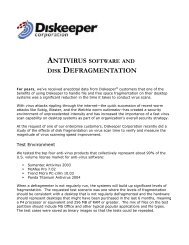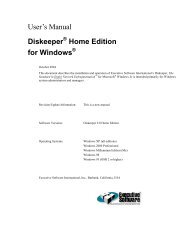Diskeeper 10 User's Manual
Diskeeper 10 User's Manual
Diskeeper 10 User's Manual
You also want an ePaper? Increase the reach of your titles
YUMPU automatically turns print PDFs into web optimized ePapers that Google loves.
68 Answers to Frequently Asked Questions<br />
That said, if you look at the DkService process using Task Manager, you will see that it uses only a few<br />
seconds of CPU time each week. The fact that it is running all the time is not going to use up system resources,<br />
or cause any problems.<br />
Since installing <strong>Diskeeper</strong>, the number of disk errors I get has increased. Why<br />
is that?<br />
<strong>Diskeeper</strong> tends to increase disk activity, and just by running, it can make weak points in the system break. In<br />
this case, you have some disk error, most likely in the free space where the Windows disk error checking utility<br />
(CHKDSK) cannot find it. This by no means indicates a problem with <strong>Diskeeper</strong>.<br />
Run CHKDSK/R on your operating system volume at least, preferably on all volumes. That should correct any<br />
errors. (CHKDSK/F may not correct this issue.)<br />
If CHKDSK itself aborts when it reaches the bad block, it indicates a disk problem which CHKDSK can't<br />
handle, and which will likely cause more trouble in the future. You should back up the volume and reformat<br />
(or replace) it to prevent the possibility of data loss due to drive failure.<br />
If you are running Windows 98/ME, run Scandisk Thorough instead of CHKDSK.<br />
How can I find which version of <strong>Diskeeper</strong> I have installed?<br />
Open <strong>Diskeeper</strong>, click the Action menu, then select About. This tells you which <strong>Diskeeper</strong> edition, version<br />
and build is installed.






